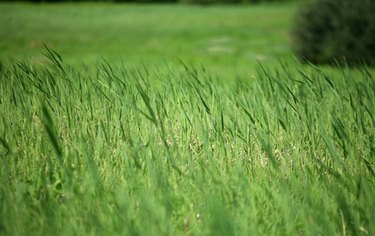Things You'll Need
Chalk
Lawn mower
Shovel
Grass seeds
Compost
Fertilizer

Field grass is a durable grass that is used on numerous athletic fields. Despite the benefits of field grass, it can encroach on the type of grass you are growing on your lawn. Popular field grass types include bent grass, Bermuda grass and fescue. Because a different type of grass growing in your lawn can create an uneven texture and look for your landscaping, remove the field grass to restore the aesthetics of your lawn.
Step 1
Locate and identify the invading grass on your lawn. Sprinkle chalk around these areas to make them easier to identify.
Video of the Day
Step 2
Lower or heighten your lawn mower's blades. Find out what height will benefit your specific grass in order to set your mower's blades. Kentucky grass can compete with other turf when it grows to 2 inches, ryegrass should be allowed to grow to 3 inches, and St. Augustine grass should be kept at 2 1/2 inches. Grass roots are as long as grass blades; therefore, the longer the blades, the better equipped they are to keep other types of turf off the yard.
Step 3
Dig up the invading field grass. Drive a shovel several inches away from the grass and lift up to remove the roots. Burn the grass or throw it away. Avoid placing this grass in your compost, because the grass seeds can return to the lawn.
Step 4
Broadcast grass seeds into the bare patches on your lawn. Rake 1/8 inch of compost over the grass seeds. Water the area with 1 inch of water (equivalent to one gallon covering 231 square inches).
Step 5
Mow your grass patches when they have reached 3 inches in height.
Tip
Fertilize your lawn in the fall to give it a jump start on healthy springtime growing.
Warning
Avoid mowing the grass down by more than 1/3 of the length of the grass blade to prevent harming the root system.
Video of the Day